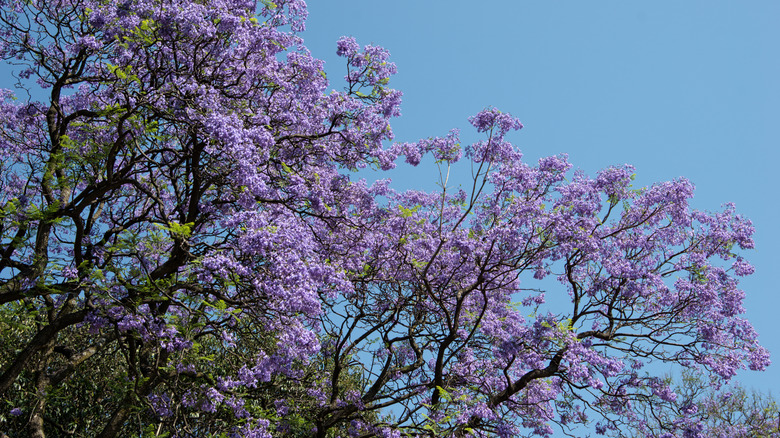Common Problems With Jacaranda Trees (And How To Prevent Them)
Also known as the fern tree because of its fern-like foliage, the jacaranda tree (Jacaranda mimosifolia) is a deciduous species prized for its profusion of lavender-blue blooms. This exotic-looking tree hails from Argentina and Bolivia, where it thrives in hot and humid conditions and well-draining soil that is kept consistently moist. While there are undoubtedly benefits of adding this stunning species to your yard, no plant is completely issue-free. Jacaranda trees are susceptible to problems like pests or disease, but there are preventative measures you can take to keep your tree as healthy as possible.
Properly care for your jacaranda tree to give it the best fighting chance. Plants that receive the right amount of nutrients, water, and sunlight tend to be less stressed and, therefore, have the energy to fight off pests or diseases. Regularly inspect your jacaranda for foliage, stem, and flower abnormalities. If the leaves are weak or new growth is yellow, it could be a sign you're giving your tree too much water. Alternatively, brown leaf edges, smaller leaves, or the leaves dropping early, signify that it needs more frequent watering. Although jacaranda trees can tolerate partial sun, they'll bloom more in an area where they receive at least six hours of daily sunlight. Unfortunately, even the best care doesn't make your tree immune to issues, so let's get into what to look out for.
Common jacaranda tree pests to watch out for
Trees are extremely important for local wildlife populations. Birds build nests to raise their young, small animals find shelter in the dense branches, and flowering species provide food for pollinators. Unfortunately, unwanted guests may also move in or make a meal out of parts of your tree. Aphids are one of the most common garden pests you'll find in the garden that suck sap from plants, leading to leaf curling, discoloration, and stunted growth. Glassy-winged sharpshooters are another problematic visitor that can introduce a fatal bacterial disease to your jacaranda tree.
It isn't always possible to prevent pests, but companion planting benefits your garden by attracting natural predators as an additional means of keeping unwanted visitors at bay. For example, marigolds are beautiful, warm-colored flowers that naturally repel aphids while attracting beneficial insects like ladybugs and parasitic wasps. Parasitic wasps feed on aphids, glassy-winged sharpshooters, and other invaders that can harm your plants, so planting marigolds close to jacaranda trees could help control insect populations. While marigolds thrive in full sun, they can benefit from the jacaranda tree's shade to protect them from the harsh afternoon sunlight in very hot climates. Check the foliage regularly for signs of pest infestation, such as discolored or curled leaves or a sticky substance left behind. One easy way to remove an infestation of aphids is to spray your tree using a high-pressure setting from the garden hose. Doing so should kill them and knock them off the tree.
Harmful diseases that affect jacaranda trees
Although jacarandas are generally resistant to disease, they can still fall victim to a few harmful problems. Bacterial leaf scorch is the most concerning issue, as it is an incurable disease. Insects like the glassy-winged sharpshooter can transmit the bacterium Xylella fastidiosa by feeding on an infected plant and then carrying it to healthy plant tissue. Affected jacarandas will have browning and dead leaves in the summer, well before they typically drop in autumn. Without intervention, the disease will worsen over the years until the entire tree is brown, and ultimately, it will die.
While there isn't a cure for bacterial leaf scorch, removing diseased branches may help prolong your tree's life. Use a clean pair of gardening shears or loppers to remove any branches with discolored leaves. To prevent spreading as you're pruning, use a solution with nine parts water and one part bleach to disinfect any trimming tools. Administering a tree injection containing an antibiotic can also help manage the condition. If the disease has taken over, it may be best to remove the tree entirely to prevent it from spreading to other plants in your garden.


